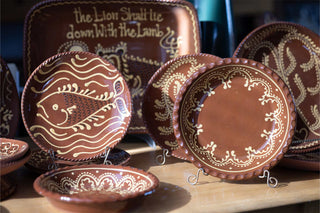Ceramic Arts Blog
Raw Materials Dictionary / Glaze making, Clay Ingredients
Alphabetical information on pottery glaze making materials and clay body ingredients: ADDITIVE A - This clay conditioner gives clay more plasticity, higher green strength and greatly increased workability throughout...
Frozen Clay and Frozen Glazes
What happens if my clay or glazes freeze? When ceramic materials freeze, water pushes the ceramic particles apart. This makes clay and glazes temporarily unusable.
Amaco Glaze Information
All AMACO® Glazes currently in production are labeled to indicate their suitability for use on food and drink containers. See the information below on this subject or refer to the...
RENAISSANCE 9-1/2 CUBIC FOOT SCHOOL / STUDIO FRONT-LOADING KILN Dimensions
Back To The Kiln...

Pottery Wheel Buying Guide
What is the best potter's wheel for me? Wheel throwing pottery is fun and rewarding but can be frustrating with the wrong tools. So buying a pottery wheel can...

Care of Your Redware
Suggestions for Care of Your Redware •FOOD SAFE•OVEN SAFE•FREEZER SAFE•MICROWAVE SAFE• Aside from its modern, food safe glaze, Henderson's Redware is no different than historic redware. Henderson's Redware is completely...

Clayscapes Glazes Mixing and Application Instructions and Tips
Amount of water to add to Clayscapes Pottery Glazes per pound: If you have Albany Gold, Arctic Blue, Brick, Clinton Pottery Red, Coastal Blue, Copper Patina, Flame, Garden Green, Lake...
Genesis Touch Screen Kiln Controller
About the Bartlett Genesis Touch Screen Controller About the Optional Bartlett GENESIS TOUCH SCREEN KILN CONTROLLER Upgrade You can now order a new L&L, Cone Art, Olympic, Paragon, and...
Kiln Buying Guide
There is a lot to think about when buying a kiln...the first question is what material do you work with? If you want to do ceramics...
G200 Type Feldspars Info
Changes in G200 Type Feldspar Information Since 2009, when the feldspar mine was depleted of the traditional G-200 potash feldspar, the ceramics industry has been constantly adjusting. In the...



